Many of the photographs here have been made available through the courtesy of Lt. Col. Peter C. Barclay, as indicated by his copyright tag (he may be contacted via his personal website). The remaining photographs are by Daniel C. Waugh. Photographs may be used for non-profit educational purposes such as classroom instruction, but permission should be obtained for any re-posting or publication (profit or non-profit) and then appropriate credit be given.


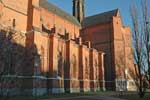

|
Views of the south façade, including portal dedicated to the cathedral's patron St. Lars.
|


|
Cathedral interior views looking east toward altar.
|
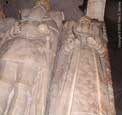
|
Sculpted figures of King Gustav Vasa (d. 1560) and his second wife Margareta Leijonhufvud on top of his cenotaph. An image of his first wife Catherine is to his right (not shown). He is buried in the Chapel of Our Lady directly to the east of the main altar, in the main apse of the cathedral.
|
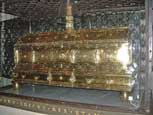
|
Reliquary casket made in 1579 for the remains of St. Erik (Jedvardsson), located in the Finsta Chapel of the cathedral.
|

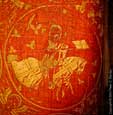

|
Details from the "martyr cope," which probably beloned to Archbishop Folke Johansson Ängel (1274-1277). Parisian work, obtained for his consecration. Unpatterned silk (samitum) with embroidery in silk and gold. Details show in order, the Coronation of the Virgin Mary, St. George on horseback, and the Decapitation of John the Baptist.
|


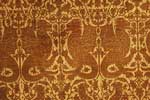

|
Details from cope of Archbishop Nicholas Alloni, acquired in Rome in 1295 on occasion of his consecration in Anagni Cathedral. Originally the background color was white. So-called Lucca brocade, with patterns in membrane gold that has darkened. The final picture shows his orphrey, which was acquired at the same time. it is embroidered in gold and silk; the medallions include Christ, St. Peter, three other apostles and a sainted bishop.
|
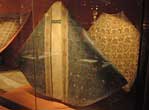
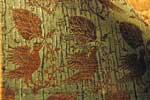


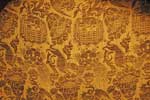
|
On left, the edge of the cope of Nicholas Alloni, in center, a cope of Lucchese (gilt membrane) brocade with design of birds, palmettes and crescents in gilt membrane and white silk on a blue (now greenish) silk ground. The Orphrey has Kufic characters (detail). N. Italy, 14th c. On right is another cope in Lucchese brocade with design of birds and dogs (detail in final picture), originally gold on red ground that has faded to yellow. N. Italy, 2nd half of 14th c.
|


|
The Virgin Mary chasuble, depicting her as celestial queen with sun's rays and the moon at her feet. Sweden, second half of 15th c., attributed to Albert the Embroiderer. Embroidered with silk, gold, silver; originally also had fresh-water pearls.
|

|
Altar frontal. Red silk velvet, Italy, 15th c. Gold embroidery, late 15th century but re-worked in 17th century.
|
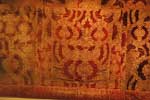
|
Altar frontal. Velvet brocade in red and gold. Italy, late 15th c. or ca. 1500. Pieced together in 17th century from liturgical vestments.
|

|
Three chausubles. On left, one depicting on top of orphrey St. Andrew. Italian white silk velvet with pomegranate design, late 15th c. Swedish embroidery, late 15th c. In center, chausuble with orphrey depcting Cucifixion. At foot of cross is Mary Magdalene, above Mary and John the Baptist. Velvet brocade in red and gold, Italy, late 15th c.; Swedish embroidery of late 15th c. attributed to Albert the Embroiderer. On right, chausuble depicting on the orphrey the Nativity, above St. John the Baptist and St. Apollonia. Velvet brocade in violet and gold, Italian, late 15th c.; embroidery, Netherlands, late 15th c.
|
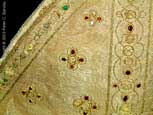
|
Detail of bishop's mitre purchased in Antwerp in 1561 for use by Archbishop Laurentius Petri, the first Lutheran Archbishop in Sweden, at the coronation of Erik XIV. Originally decorated with additional precious stones, including pearls and turquoise.
|

|
Brocade fragment (detail). Dark blue warp-faced satin, asymmetrical design of palmettes and foliage. China, 14th c. or earlier.
|


|
Textile fragment. Italy, late 15th c., Silk damask with pomegranate design and embroidered ornament of carnations.
|


|
The golden gown of Queen Margareta of Denmark, Norway and Sweden.. The only surviving medieval gala dress. Italian gold brocade with pomegranate pattern in gold on purple silk background. Carbon dated 1403-1439. Karl X Gustav took it from the queen's tomb at Roskilde (Denmark) in 1659 and brought it as war booty to Sweden, where the royal family gave it to the cathedral in 1665. The brocade is not preserved intact-it originally extended the full length along the whole bottom hem.
|

|
The Sture costumes. The clothing worn (l. to r.) by Count Svante Stensson Sture (1517-1567), Nils Svantesson Sture (1543-1567) and Erik Svantesson Sture (1546-1567) at time of their murder by King Erik and his soldiers. They were buried in Uppsala Cathedral. After their deaths, Svante Sture's widow preserved the clothing in a chest which is displayed next to the clothes. Svante Sture's and Erik Sture's doublets are velvet; Nils Sture's doublet is of chamois leather; and the britches are of taffeta with black velvet panes.
|


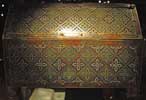
|
Reliquary depicting Christ in Majesty, center top, standing apostles on sides and St. Peter on the end. St. Paul is on the other end panel (not shown). The reverse side and top of the reliquary has ornamental rosette pattern. Limoges. Enamelled and gilded copper, late 12th c. The reliquary possibly belonged to the first episcopal cathedral in Old Uppsala.
|
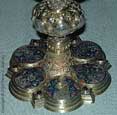
|
Base of chalice donated to cathedral by Canon Ödhinus in 1340s. The original bowl/cup was replaced by a larger one at end of 18th c. Probably Swedish-made. Silver, gilded and enameled, depicting on base Christ and several of the Apostles.
|

|
Two wine spoons, one on left depicting St. George; on right the Lamb of God. Silver gilt, 16ht c. and ca. 1600 respectively.
|
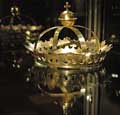
|
Funeral crown made in conjunction with funeral of King Gustav Vasa in 1560. Silver gilt.
|
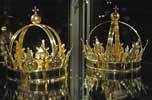

|
Two funeral crowns, made in 1560 by Hans Rosenfelt of Stockholm for Catherine of Saxe-Auenburg (d. 1535) and Margareta Leijonhufvud (d. 1551), the first two wives of King Gustav Vasa in conjunction with his funeral. Silver gilt.
|

|
Funeral crown for Queen Katarina Stenbock (1535-1611, the third wife of King Gustav Vasa). Pearls threaded on silver wire.
|

|
Two funeral crowns. On right, that for King Johan III (d. 1592), gold and enamel, decorated with emeralds and garnets. On left, that for his wife, Queen Catherine Jagiellonica (d. 1583), gold with sapphires, garnets and pearls.
|

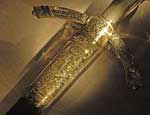
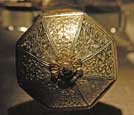

|
Two swords from royal funeral regalia. On top (with two details), sword recovered from tomb of Gustav Vasa. Silver gilt hilt with cast and engraved ornamentation, depicting Adam and Eve. Ca. 1540. On bottom, rapier with gilt iron hilt, orginally with black velvet sheath. Recovered from coffin of Gustav Vasa's son, King Johan III (d. 1592).
|
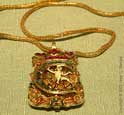
|
Pendant with monogram C. Nürnberg, made by goldsmith Nicholas Nonarth in 1546. Given to Catherina Jagiellonica (1526-1583) , by her father, Sigismund I, King of Poland. Recovered from her coffin. Gold, enamel, gemstones, including diamonds and rubies.
|

|
Buttons from burial costume of Swedish King Johan III (1537-1592). Gold Moorish pattern against blue enamel background.
|
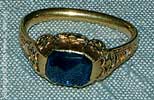
|
Ring, part of funeral regalia for Prince Gustav (1574-1597), grandson of King Gustav Vasa. Gold with sapphire and enamel.
|


















































